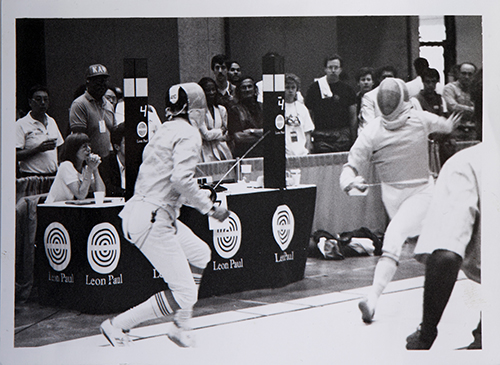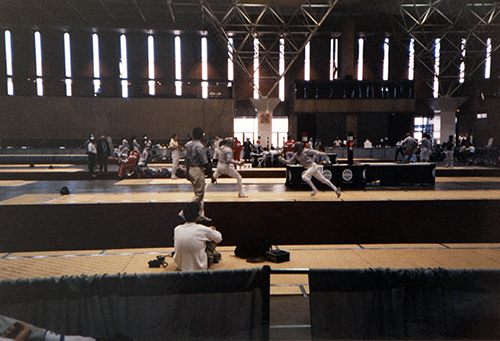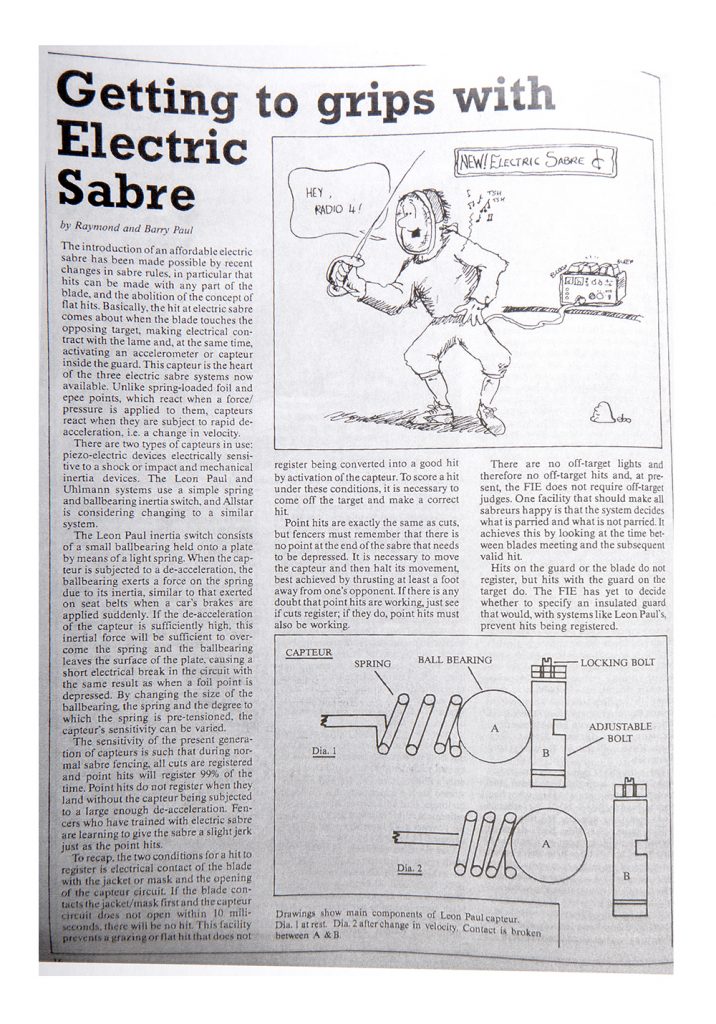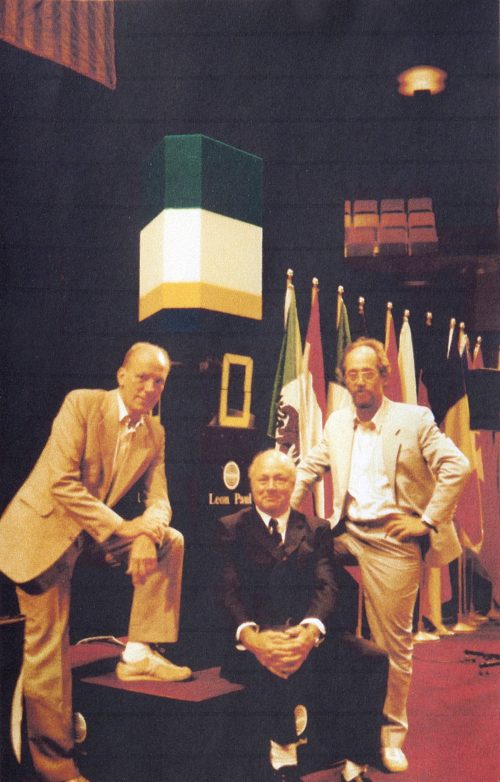We use cookies
Using our site means you agree to the use of cookies and similar technologies. Read about our policy and how to disable them here
 Action from the poules.[/caption]
[caption id="attachment_1146" align="aligncenter" width="500"]
Action from the poules.[/caption]
[caption id="attachment_1146" align="aligncenter" width="500"] A wider view of the main hall.[/caption]
On the day before the individual sabre started the senior member of the SEMI requested to have the sensor for testing and setting. I queried this explaining that although the SEMI had at some point drawn up a protocol for setting the impact at which the captor should open and therefore allow a hit to be registered, the captors had not be set to this setting at any competition leading up to the championship. It was against general fencing regulations to impose any new technical changes less than a year before a World Championships or Olympic Games. My fear was that as soon as fencing started there would be a riot as the fencers having fenced for a year with one sensor setting found that it had been changed. Even worse they would decide that it was the fault of the Leon Paul apparatus and ruin our reputation, (Imagine what would have happened if foil or epee fencers suddenly were made to start fencing with treble the normal spring pressure?) The SEMI insisted that they set the captors according to their protocol. In the evening we were given the set captors back. I tried the set captors in a sabre and it confirmed my worst fears. Next day half an hour before the event was due to start we gave back the captors to the organisers and SEMI reset to how they had been set for the previous year, telling everyone that if the capteurs were touched and reset Leon Paul and all its staff would leave the building. After short a Mexican standoff between Leon Paul the organising committee and the SEMI the competition was started without the capteurs being touched. The capteurs remained as we had set them and the event proceeded without issues regarding the force required to make a hit.
[caption id="attachment_1151" align="aligncenter" width="716"]
A wider view of the main hall.[/caption]
On the day before the individual sabre started the senior member of the SEMI requested to have the sensor for testing and setting. I queried this explaining that although the SEMI had at some point drawn up a protocol for setting the impact at which the captor should open and therefore allow a hit to be registered, the captors had not be set to this setting at any competition leading up to the championship. It was against general fencing regulations to impose any new technical changes less than a year before a World Championships or Olympic Games. My fear was that as soon as fencing started there would be a riot as the fencers having fenced for a year with one sensor setting found that it had been changed. Even worse they would decide that it was the fault of the Leon Paul apparatus and ruin our reputation, (Imagine what would have happened if foil or epee fencers suddenly were made to start fencing with treble the normal spring pressure?) The SEMI insisted that they set the captors according to their protocol. In the evening we were given the set captors back. I tried the set captors in a sabre and it confirmed my worst fears. Next day half an hour before the event was due to start we gave back the captors to the organisers and SEMI reset to how they had been set for the previous year, telling everyone that if the capteurs were touched and reset Leon Paul and all its staff would leave the building. After short a Mexican standoff between Leon Paul the organising committee and the SEMI the competition was started without the capteurs being touched. The capteurs remained as we had set them and the event proceeded without issues regarding the force required to make a hit.
[caption id="attachment_1151" align="aligncenter" width="716"] Extract from the winter 1988 edition of the Sword Magazine.[/caption]
Due to the inexperience of the fencers, in some cases this was the first time they had fenced with an electric sabre, there was a huge number of kit related issues which the fencers invariably blamed on faulty apparatus. Fortunately, Derrick Cawthorne was a top world class referee and technician. His knowledge and experience allowing us to run from piste to piste solving issues which were personal kit faults. Anybody following Derrick would have seen a Masterclass in on the piste fault finding. I remember that whereas most piste technicians came on the piste with a kit of tools and devices Derrick had only a three pin socket with line B and C
shorted and a coin to short out the lines. Two issues which I remembered clearly, the first an Asian fencer who was convinced that the apparatus was faulty as it did not register fast hits. He proceeded to demonstrate and indeed it seemed to show that fast hits did not register. This could not be an apparatus fault so the problem must be with the fencer kit. Derrick proceeded to eliminate the spool, his sabre and then found the cut in his bodywire just near the weapon socket. Slow hits worked but fast hits which involved stretching his arm resulted in the body wire cable being stretched and breaking the continuity of the wire preventing a hit registering. The second case was a French fencer who was being difficult to hit, by the time I arrived the spool had been changed and the fencer was demanding that the apparatus be changed. After eliminating everything else it was clear the fault was an intermittent break in the line from his three pin plug to his crocodile clip. Initially, he refused to change his body wire saying it was a new Prieur body wire so it could not be faulty. I convinced the referee I was correct and while the fight resumed with the fencer using his spare body wire I took the plug apart to show a faulty connection (the fixing screw in the three pin plug was missing)
[caption id="attachment_1189" align="aligncenter" width="500"]
Extract from the winter 1988 edition of the Sword Magazine.[/caption]
Due to the inexperience of the fencers, in some cases this was the first time they had fenced with an electric sabre, there was a huge number of kit related issues which the fencers invariably blamed on faulty apparatus. Fortunately, Derrick Cawthorne was a top world class referee and technician. His knowledge and experience allowing us to run from piste to piste solving issues which were personal kit faults. Anybody following Derrick would have seen a Masterclass in on the piste fault finding. I remember that whereas most piste technicians came on the piste with a kit of tools and devices Derrick had only a three pin socket with line B and C
shorted and a coin to short out the lines. Two issues which I remembered clearly, the first an Asian fencer who was convinced that the apparatus was faulty as it did not register fast hits. He proceeded to demonstrate and indeed it seemed to show that fast hits did not register. This could not be an apparatus fault so the problem must be with the fencer kit. Derrick proceeded to eliminate the spool, his sabre and then found the cut in his bodywire just near the weapon socket. Slow hits worked but fast hits which involved stretching his arm resulted in the body wire cable being stretched and breaking the continuity of the wire preventing a hit registering. The second case was a French fencer who was being difficult to hit, by the time I arrived the spool had been changed and the fencer was demanding that the apparatus be changed. After eliminating everything else it was clear the fault was an intermittent break in the line from his three pin plug to his crocodile clip. Initially, he refused to change his body wire saying it was a new Prieur body wire so it could not be faulty. I convinced the referee I was correct and while the fight resumed with the fencer using his spare body wire I took the plug apart to show a faulty connection (the fixing screw in the three pin plug was missing)
[caption id="attachment_1189" align="aligncenter" width="500"] From right to left, Derrick Cawthorne, Raymond Paul and Barry Paul.[/caption]
The following year our apparatus was used at the World Championships in Lyon.
To my knowledge, the FIE never followed up the setting of capteurs to any standard in a sensible way, which was a real pity as the capteurs set as per the FIE protocol could have made sabre fencing a better more realistic event ensuring/helping only hits with force would register.
From right to left, Derrick Cawthorne, Raymond Paul and Barry Paul.[/caption]
The following year our apparatus was used at the World Championships in Lyon.
To my knowledge, the FIE never followed up the setting of capteurs to any standard in a sensible way, which was a real pity as the capteurs set as per the FIE protocol could have made sabre fencing a better more realistic event ensuring/helping only hits with force would register.
